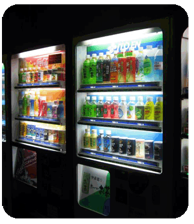 People today are becoming less and less dependent on cash, though you wouldn’t know it from looking at most vending machines. More than 40 percent of American adults said in a recent survey that they could go a week without paying for something in cash. Meanwhile, many of the nation’s vending machines continue to accept only bills and coins. This reluctance to change likely led to the vending industry’s 18.3 percent drop in sales between 2007 and 2011. When revenues recovered a bit in 2012, experts credited it to the increasing number of “smart” vending machines on the market.
People today are becoming less and less dependent on cash, though you wouldn’t know it from looking at most vending machines. More than 40 percent of American adults said in a recent survey that they could go a week without paying for something in cash. Meanwhile, many of the nation’s vending machines continue to accept only bills and coins. This reluctance to change likely led to the vending industry’s 18.3 percent drop in sales between 2007 and 2011. When revenues recovered a bit in 2012, experts credited it to the increasing number of “smart” vending machines on the market.
Adding credit card capabilities is just the first step towards bringing a vending machine up to current standards. While plastic-friendly units can boost sales by as much as 30 percent, a number of other advanced features are transforming vending machines from 20th century relics into modern marvels. First and foremost, connectivity to the Internet allows vendors to track every aspect of their machines from stock to sales. Without the need to inspect each machine one at a time, operators can reduce their maintenance truck fleets by as much as 40 percent. Access to the web also allows vendors to install digital touch screens that periodically display advertisements. In fact, one researcher found that revenues per transaction rise 15 to 20 percent when machines prompt consumers about additional items.
Experts estimate that there are 500,000 to 700,000 smart vending machines on the market today. By 2018, there could be as many as 2 million of them located across the country. Although the benefits of smart vending machines are apparent, making the switch can be expensive for many operators. New fully loaded units sell for well over $10,000. Even adding a baseline service like web capabilities to an older machine can cost north of $500. Most vending machine operators own fewer than 20 units and run on thin margins, making even minor improvements a tall order. But like so many companies over the last decade, in the end they may have no choice but to embrace this costly new technology in order to keep their businesses afloat.
Questions:
- What products are most appropriate for vending machines?
- If vending machines upgrade to smart machines will their product mix expand?
Source: Olga Karif, “Vending Machines Get Smart to Accommodate the Cashless,” Bloomberg BusinessWeek, August 29, 2013. Photo courtesy of Mike Lee.
